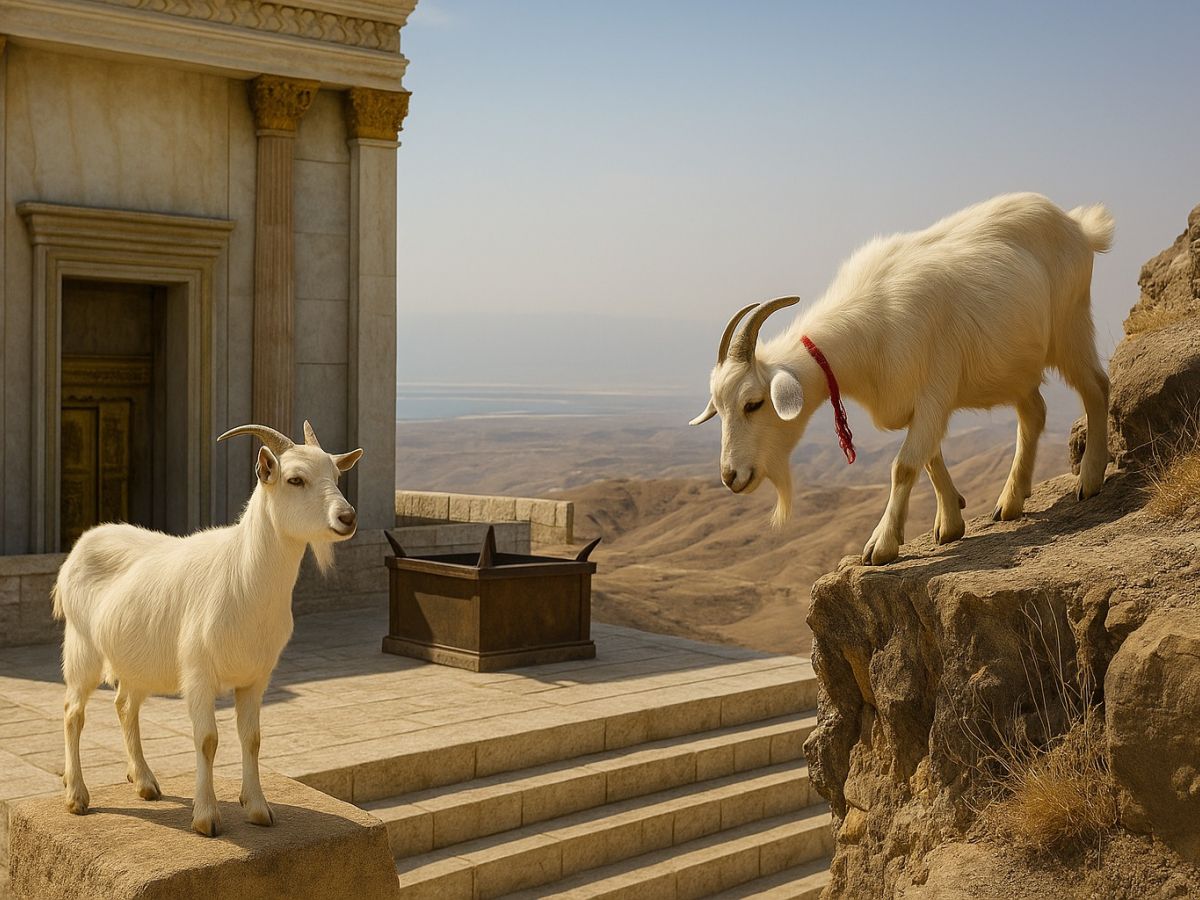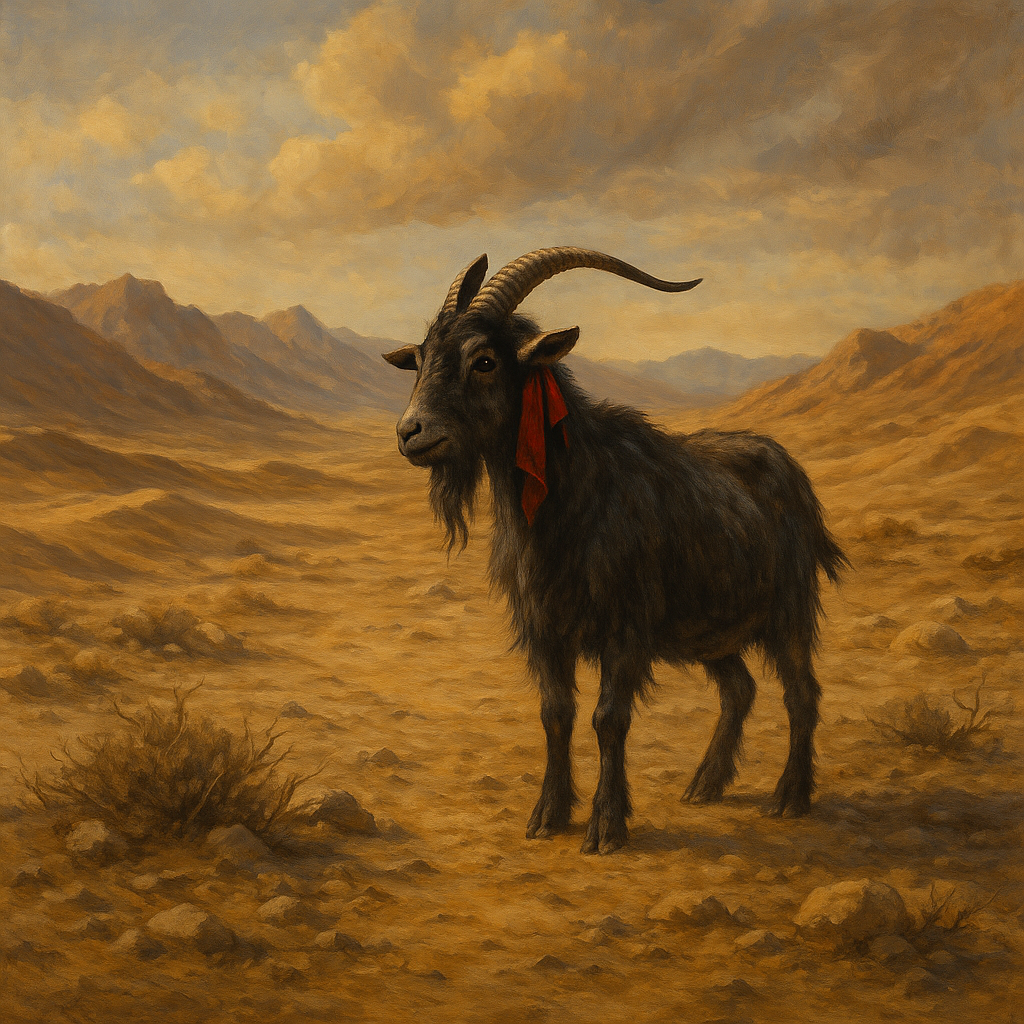
Yeshua, the Wilderness Goat and the Sin-Bearer Who Returns
Each year on Yom Kippur, two goats stood before the high priest in Jerusalem—one chosen “for the Lord,” the other designated “for Azazel,” the wilderness goat figure associated in early Jewish tradition with chaos, impurity, and the demonic realm. The first goat was sacrificed and its blood carried into the Holy of Holies to cleanse the sanctuary. The second goat, the wilderness goat, had the sins of Israel placed upon its head, after which it was driven outside the camp and into the wilderness.
Later rabbinic tradition preserves a stark detail: the wilderness goat was pushed off a cliff so that Israel’s sins could never find their way back into the camp. The message was clear. One goat restored holiness within the sanctuary; the other, the wilderness goat, removed pollution from the community. Yet the ritual, powerful as it was, remained temporary. The goat could bear sins away for a time but could not conquer them; the ritual had to be reenacted every year.
The Wilderness Goat symbolizes Exile and Chaos
In the Hebrew imagination, the wilderness was more than a wasteland. It represented the borderlands of creation—the space where the ordered world gave way to chaos, danger, and scarcity. It was the place of wild beasts, demons, and de-creation, and symbolically the space tied to exile.
Yet paradoxically, it was also the place where God reshaped His people. Israel’s forty-year wandering was both a discipline accompanied by God’s mercy, the crucible where the nation was humbled, tested, and ultimately restored at Sinai. The wilderness held both judgment and new creation, the threat of death and the possibility of transformation.
Yeshua Driven Into the Wilderness
Immediately after His baptism and anointing as the beloved Son—the Spirit drove Yeshua into that same wilderness (Mark 1:12). This was not a retreat into solitude but a deliberate symbolic confrontation with the forces Israel had battled for centuries.
Second Temple writings such as 1 Enoch and Jubilees associate Azazel with haSatan, the adversary and accuser. If the goat “for Azazel” carried Israel’s sins into the domain of demonic powers, then Yeshua’s entry into the wilderness is the counter-movement: He enters the realm where sin was banished in order to defeat the power behind it.
The wilderness goat wandered into chaos and never returned; Yeshua enters the same chaos but emerges victorious. He becomes the faithful Israelite who withstands temptation, the obedient Son who succeeds where Adam and Israel failed, and the greater Moses who ascends the mountain without compromise.
Outside the Camp: The Wilderness Goat and the Crucified King
The connection between Yeshua and the wilderness goat becomes even clearer within the passion narratives. Hebrews notes that Jesus “suffered outside the gate in order to sanctify the people through His own blood” (Heb. 13:12). Like the wilderness goat, He is expelled beyond the sacred boundaries, crucified outside Jerusalem’s walls—symbolically a place of exile. There, on Roman wood instead of jagged cliffs, He bears the burden of Israel’s sin “in His own body on the tree” (1 Pet. 2:24). In Him the two goats converge: like the goat “for the Lord,” His blood purifies the true heavenly sanctuary; like the goat for Azazel, He carries sin outside the camp into death itself. But the great reversal lies in what happens next. Unlike the goat, Yeshua does not remain in exile. He returns with victory.
Exile Reversed: Retracing the Yom Kippur Path
The desert geography illuminates this reversal. The wilderness goat traveled eastward from the Temple, across the Kidron Valley, up the Mount of Olives, and down into the Judean wilderness toward the Dead Sea—the great basin. It symbolized Israel’s sin being carried away from the presence of God.
But Yeshua retraces this route only in reverse. He begins His ministry east of the Jordan, moves westward into the wilderness, ascends the Mount of Olives, and ultimately enters Jerusalem. It is the path of homecoming where Israel once walked as they returned from Babylonian exile.
Yeshua embodies the return. He is both the rejected David who fled Jerusalem weeping over the Mount of Olives during Absalom’s rebellion and the restored king who later crossed the Jordan in triumph. He is both the burdened goat who enters the wilderness and the victorious Son who returns without sin. The path of exile thus becomes the path of restoration.
The Crimson Thread and the Once-for-All Offering
Second Temple tradition also remembered a crimson thread tied to the goat’s horns, which was said to turn white when the ritual was accepted—a sign that Israel’s sins had been cleansed. Another crimson thread hung at the Temple’s Nicanor Gate, also turning white when atonement was granted.
But these were signs of temporary relief, yearly reassurances that God had once again removed impurity from His people. Hebrews insists that Yeshua’s offering is “once for all” (Heb. 10:10). In Him the sign becomes the substance. No yearly banishment is required; no symbolic goat must be sent into the desert. Sin is not simply carried away—it is abolished at its roots.
The Wilderness Rewritten as the Place of Victory
With Yeshua, the wilderness itself is reinterpreted. The terrain once associated with exile and demonic threat becomes the arena of divine triumph. The forces that held humanity in bondage are confronted and overcome. The chaos that once devoured becomes the doorway to new creation. The realm of Azazel, long associated with impurity, becomes the battleground where Yeshua binds the strong man and inaugurates the kingdom of God. What was once the place where Israel’s sins were sent to die becomes the place where resurrection begins.
The New Exodus Has Begun
This is also the heart of the New Exodus. Yeshua’s journey—through the waters of the Jordan, into the wilderness, up the mountain, and into the city—traces Israel’s story and brings it to completion. He descends into the realm of exile and emerges to lead His people home. The writer of Hebrews therefore invites believers to follow Him “outside the camp” (Heb. 13:13) and to share in His path of suffering and resurrection. To go to Him outside the camp is to join Him in His confrontation with the forces that enslave, and to return with Him in the power of new creation.
In this great reversal, Yeshua emerges as the once-for-all wilderness goat, the returning Son of David, and the Divine Warrior whose victory transforms the landscape of atonement. He turns wilderness into worship and exile into Eden. In Him the end of the story comes into view: the God who once sent a goat away now sends His Son back to gather the nations home. Through Him, the wilderness is not the end; it is the doorway through which new creation dawns.
The Sin-Bearer Who Comes Back
This is the heart of the gospel’s inversion. The wilderness goat removes Israel from sin for a year; Yeshua removes sin from Israel forever. The goat goes out and never returns; Yeshua goes out and comes back in resurrection glory. The goat’s death provides temporary relief; Yeshua’s death inaugurates the age to come. He is the true sin-bearer whose return signals the end of exile.


Leave a Reply